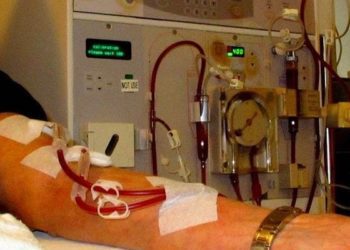New mutations behind heritable hypercalcemia and hypocalcemia identified
Image: PD G protein coupled receptor
1. Loss-of-function mutations in Gɑ11 cause type 2 familial hypocalciuric hypercalcemia.
2. Gain-of-function mutations in Gɑ11 can cause autosomal dominant hypocalcemia
Study Rundown: The calcium-sensing receptor (CaSR) is expressed in two key regulators of calcium homeostasis: the parathyroid and the kidney. High levels of calcium activate CaSR, leading to inhibition of parathyroid hormone (PTH) release and reduced calcium reabsorption in the renal tubules. CaSR, in effect, determines the body’s calcium set point.
In type 1 familial hypocalciuric hypercalcemia, the body’s calcium set point is increased by loss-of-function mutations in CaSR. On the other hand, CaSR gain-of-function mutations lower the calcium set point. This is known as autosomal dominant hypocalcemia.
Since CaSR is a G-protein coupled receptor (GPCR), the authors hypothesized that inactivating and activating mutations in the coupled G-protein, Gɑ11, could cause subtypes of FHH and autosomal dominant hypocalcemia, respectively.
Indeed, a Gɑ11 loss-of-function mutation was found in a family with type 2 FHH and Gɑ11 gain-of-function mutations were identified in 2 individuals with autosomal dominant hypocalcemia.
Click to read the study in the New England Journal of Medicine
Relevant Reading: Diseases associated with the extracellular calcium-sensing receptor
In-Depth [genetic study]: A 3-base pair deletion in the gene encoding Gɑ11 was found to co-segregate with the disease in a family with type 2 FHH. A missense mutation in the gene was also identified in an unrelated individual with FHH. In vitro, these mutations were shown to reduce the sensitivity of cells to extracellular calcium, suggesting a loss of function in Gɑ11. Protein modeling suggests that the mutations inhibit the enzyme’s ability to transition to its active state.
The authors were also able to find missense mutations in Gɑ11 in two patients with hypocalcemia. In vitro studies showed that these mutations increased the sensitivity of cells to extracellular calcium – a gain of function. Protein modeling suggests that the mutations prolong the time Gɑ11 spends in its active GTP-bound state.
This study provides convincing evidence for the role of Gɑ11 in forms of hypercalcemia and hypocalcemia by combining genetic, in vitro and protein modeling data. However, Gɑ11 mutations are not the final word on FHH or autosomal dominant hypocalcemia. Only 3 of the 18 unrelated patients tested had Gɑ11 mutations. The mutations in the other 15 remain unknown.
By Tomi Jun and Mitalee Patil
More from this author: Researchers improve lung cancer risk model by incorporating more risk factors, Study hints at causal link between lipoprotein(a) and calcific aortic stenosis, Peginasetide non-inferior to EPO for chronic kidney disease patients not on dialysis [PEARL Trials],Video surveillance sheds light on causes of falls in the elderly, [In the News] Extended tamoxifen regimen reduces mortality for subset of breast cancer, [Researcher Comment] Whole-genome sequencing helps halt MRSA bacterial outbreak, [In The News] Modest protection conferred by malaria vaccine in phase 3 trial, [Physician Comment] Multiple sclerosis: Anti-cancer drug beats current first-line treatment in phase 3 trial, A molecular link between sleep deprivation and insulin resistance, A phase I trial of neural stem cells in a disease of myelination shows promising results, Diagnostic exome sequencing in persons with severe intellectual disability finds new candidate genes, HPV vaccine associated with minimal adverse effects, Four different types of breast cancer revealed based on molecular data, Acupuncture helpful for chronic pain: new meta-analysis [Arch Intern Med.]
© 2013 2minutemedicine.com. All rights reserved. No works may be reproduced without written consent from 2minutemedicine.com. Disclaimer: We present factual information directly from peer reviewed medical journals. No post should be construed as medical advice and is not intended as such by the authors or by 2minutemedicine.com. PLEASE SEE A HEALTHCARE PROVIDER IN YOUR AREA IF YOU SEEK MEDICAL ADVICE OF ANY SORT. Content is produced in accordance with fair use copyrights solely and strictly for the purpose of teaching, news and criticism. No benefit, monetary or otherwise, is realized by any participants or the owner of this domain.









